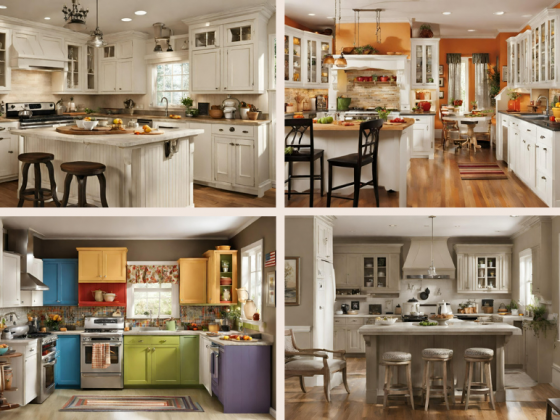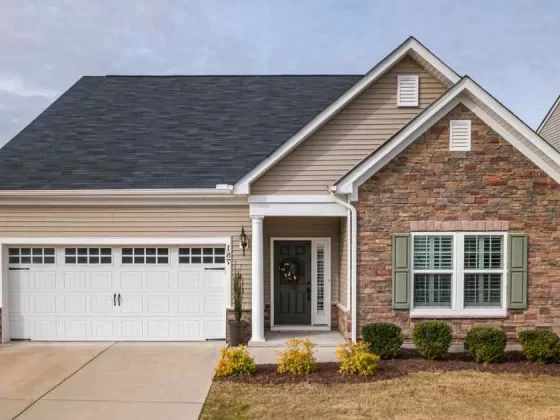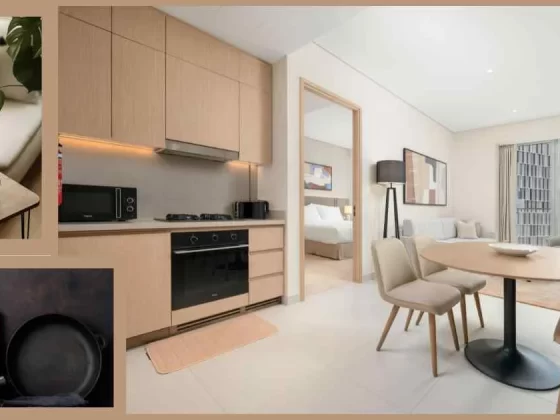Every morning, you open your front door and look at the same small patch of grass — dry, uneven, or simply dull. Maybe you’ve dreamed of turning it into something special, but the idea of maintaining a full garden feels overwhelming. Here’s the secret: you don’t need a huge space or endless free time to make your outdoors feel alive.
Imagine this instead — stepping outside to soft greenery, the scent of herbs, or a few bright flowers gently moving in the breeze. Birds drop by for a visit. Neighbors slow down to compliment your yard. And the best part? You barely lift a finger to keep it that way.
This guide shows you exactly how to transform your house front mini garden into a beautiful, low-maintenance haven — from the first design sketch to your final relaxing seat among the plants.
Why a Low-Maintenance House Front Mini Garden Is Worth It
Your front yard is more than just space between your door and the street — it’s the “handshake” of your home. It can greet guests, boost curb appeal, and even make your daily routine feel calmer.
The Benefits You’ll Enjoy
-
Instant curb appeal – A tidy, intentional garden makes your home look cared for and stylish.
-
Emotional lift – Studies show spending time in green spaces reduces stress and boosts mood.
-
Environmental value – Even small gardens attract pollinators, reduce heat, and improve air quality.
-
Less work, more reward – With a smart layout and resilient plants, you’ll enjoy beauty without constant upkeep.
As experts at Better Homes & Gardens note, a well-designed front yard can balance aesthetics with ease when it replaces traditional lawns with shrubs, groundcovers, and pathways.
Step 1: Plan Like a Pro — So Your Garden Practically Maintains Itself
A thriving house front mini garden starts on paper, not in soil. The best gardens aren’t random; they’re intentional.
1.1 Take a Snapshot of What You Have
Before you rush to plant, step outside with a notebook. Ask yourself:
| Element | What to Check | Why It Matters |
|---|---|---|
| Sunlight | Track hours of direct light daily | Determines what plants will thrive |
| Soil | Is it sandy, clay, or loamy? Does water drain well? | Influences plant health and root growth |
| Space & Shape | How much area do you have? Any slopes or obstacles? | Guides plant spacing and paths |
| Existing Features | Walkways, fences, steps | Work with them instead of fighting them |
| Lifestyle | How much time do you truly want to spend maintaining it? | Defines “low-maintenance” for you |
Pro Tip:
Stand outside at different times of day. Light changes dramatically — a “sunny” yard may actually be in shade by noon!
1.2 Define Your Vision
Your mini garden should reflect you.
Ask yourself:
-
Do I want lush greenery or colorful blooms?
-
Should it attract butterflies or birds?
-
Do I want to grow herbs or enjoy the view?
-
How much time do I realistically have each week for care?
Write your priorities down — and stick to them. This clarity keeps you from impulse-buying plants that don’t fit your plan.
1.3 Sketch a Simple Layout
You don’t need to be an artist. Draw rough shapes showing where paths, plant beds, and a focal point (like a small tree or garden pot) might go. You can also use AI to generate possible looks by taking a picture and attaching it for AI to do the possible outcomes.
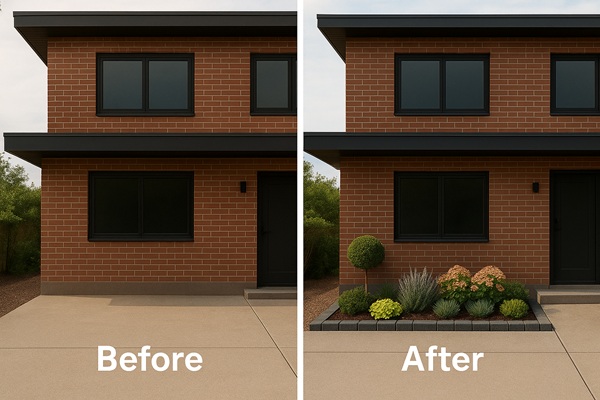
Quick Layout Tips:
-
Keep symmetry simple — it gives calmness.
-
Use curves instead of sharp lines; they make small spaces feel bigger.
-
Leave space to walk or reach plants easily.
Step 2: Build a Low-Maintenance Foundation — Hardscape First
Think of hardscape as your garden’s bones — paths, edges, stones, and sitting areas. These define structure and dramatically cut down future work.
2.1 Replace High-Maintenance Lawn with Smart Surfaces
Swap grass for:
-
Decorative gravel or river rocks
-
Pavers or stepping stones
-
Raised beds or containers
-
A small sitting corner with tiles
Even reducing the lawn by 50% can slash your maintenance time, according to Bower & Branch Landscaping.
2.2 Use Strong Borders
Install edging (metal, stone, or brick) to separate planting beds from walkways — clean edges instantly make any garden look organized and prevent grass or weeds from creeping in.
2.3 Mulch Magic
Mulch is your low-maintenance best friend. It:
-
Smothers weeds
-
Keeps soil moist
-
Adds a finished, professional look
Use bark, wood chips, or crushed gravel. Apply 3–5 cm deep, topping up annually.
Design Secret:
Use contrasting textures — like smooth pavers against soft mulch — for instant visual interest.
2.4 Automate Watering
If your budget allows, install a simple drip irrigation system with a timer. Once set, it waters efficiently with almost no effort.
Step 3: Pick Plants That Thrive on Neglect (and Still Look Gorgeous)
Here’s where your house front mini garden truly comes alive. Choosing resilient plants means your yard stays lush without constant care.
3.1 The Golden Rules of Plant Selection
-
Choose native plants: They’re adapted to local weather, pests, and soil.
-
Prioritize perennials and evergreens: No need to replant yearly.
-
Use shrubs, grasses, and groundcovers: They fill space and block weeds.
-
Mix textures, not just colors: Combine leafy greens, soft grasses, and a few blooms.
3.2 Tried-and-True Plant Suggestions
| Plant Type | Example | Why It Works |
|---|---|---|
| Dwarf shrubs | Boxwood, Little Bonnie Spirea | Evergreen shape, easy pruning |
| Evergreen shrubs | Yewtopia plum yew, Loropetalum | Keeps structure year-round |
| Ornamental grasses | Fountain grass, Carex | Airy texture, one trim per year |
| Groundcovers | Creeping thyme, Vinca minor | Covers soil, fights weeds |
| Succulents/perennials | Sedum, daylilies | Thrive in heat, low water needs |
| Focal plants | Dwarf Japanese maple, small citrus tree | Adds height and character |
Pro Tip:
Choose three main colors max — repetition creates harmony and calm.
Step 4: From Plan to Plant—Bringing Your Vision to Life
4.1 Prepare the Ground
-
Clear weeds and old turf completely.
-
Loosen soil and mix in compost.
-
Check drainage — water shouldn’t pool after rain.
-
Lay down mulch or landscape fabric where needed.
4.2 Smart Planting Order
-
Install hardscape (paths, edging) first.
-
Place large shrubs or trees next.
-
Add medium plants and fillers.
-
Finish with groundcovers and mulch.
Mini Challenge:
Before you start planting, take a “before” photo. You’ll love comparing it with your mini garden in a few months.
4.3 Example Layout (Small Space: 3m x 5m)
-
Back row: Two dwarf hydrangeas for height
-
Middle: Ornamental grasses and boxwoods
-
Front edge: Creeping thyme and lavender
-
Focal point: A ceramic pot with a compact maple
Result: Structured, fragrant, and green all year — and nearly self-sustaining.
Step 5: The “Set It and Forget It” Care Routine
Low-maintenance doesn’t mean zero effort — just smart, scheduled upkeep.
| Task | Frequency | Why It Matters |
|---|---|---|
| Light weeding | Monthly | Stops spread early |
| Pruning | Once or twice yearly | Keeps the shape clean |
| Mulch renewal | Annually | Prevents weeds |
| Watering | As needed (automated if possible) | Establishes healthy roots |
| Cleaning paths | Occasionally | Keeps tidy and safe |
Pro Tip:
Set a recurring reminder once a month: “15-Minute Garden Check.” Quick inspections prevent big issues.
Real-Life Story: Sarah’s Weekend-Free Garden
Sarah, a full-time teacher, once dreaded mowing her narrow front strip every Saturday. After a simple redesign using gravel, hydrangeas, thyme, and one dwarf maple, she says:
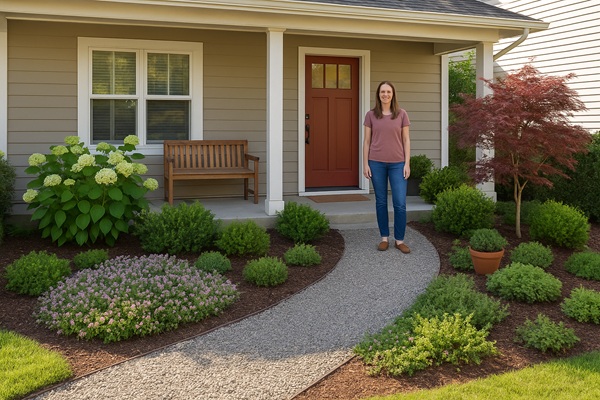
“Now, my front yard feels like a little park. I spend less than an hour a month maintaining it — and I finally love walking to my front door.”
Her house front mini garden became a personal retreat instead of a chore list — and that’s the essence of smart gardening.
Common Mistakes (and How to Avoid Them)
-
Overplanting—It looks lush at first, but soon it becomes overcrowded. Leave room for growth.
-
Mixing sun and shade plants—match plants to real light conditions.
-
Ignoring mature size—dwarf shrubs may still double in width.
-
Skipping mulch—you’ll regret it when weeds return.
-
No pathways—always create access for easy care.
-
Planting too close to walls — Allow airflow to prevent mold.
Quick Fix:
Follow the “Rule of Thirds”: one-third hardscape, one-third shrubs, one-third fillers or groundcovers. Balanced, easy, beautiful.
Seasonal Adjustments for Year-Round Ease
-
Spring: Refresh mulch, check irrigation, and trim winter damage.
-
Summer: Minimal watering if plants are established; enjoy blooms.
-
Autumn: Light pruning and removing fallen leaves.
-
Winter: Leave ornamental grasses standing for texture and wildlife habitat.
Design & Lifestyle Tips
-
Add solar path lights for soft nighttime charm.
-
Use planters near the door for quick refreshes each season.
-
Pair your mini garden with a small bench or potting nook — even 1 m² makes a big difference.
-
Choose eco-friendly materials (recycled pavers, organic mulch).
-
Incorporate bird feeders or bee-friendly flowers for life and motion.
Bringing It All Together: Your 7-Step Action Plan
-
Evaluate your space (sun, soil, size).
-
Visualize your dream garden and goals.
-
Lay hardscape for structure and less work.
-
Pick resilient plants suited to your climate.
-
Plant smartly with space and mulch.
-
Automate watering or keep a simple routine.
-
Enjoy and adjust seasonally—not weekly.
Your Front Yard, Reimagined
Your house front mini garden doesn’t have to be grand or expensive—it just needs intention. With the right mix of hardscape, low-care plants, and a few creative touches, your small front yard can become a sanctuary that welcomes you home every single day.
Start with one section, one planter, or one idea from this guide. Each small improvement adds up. In a few months, your front yard will not only look transformed—it will feel different too. You’ll notice the calm, the pride, and the joy that come from creating beauty that truly fits your lifestyle.
After all, the best gardens aren’t the ones that need you every day—they’re the ones that quietly give back while you live your life.




